Philodendrons are at home in the tropical rainforest where they climb up trees, and thrive in the dappled sunlight of the under-story. This is quite a diverse group of plants, with both upright forms of the plant, and climbing / trailing types. The trailing types of Philodendron are most popular as indoor plants, with the colourful leaves being the main feature. A lot of the upright types of Philodendron can be used outdoors in a temperate to warm climate. Used in a shady spot, they can add a charm and tropical feel to garden positions where other plants may not do the job.
I have photographed two types of Philodendron here. One is Philodendron selloum, which is an upright plant with very large leaves - more than a metre long. This is a very hardy plant as long as it gets regular water and is kept out of the full sun. It is Native to South America. The next philodendron here, is the Philodendron "Xanadu". This is a dwarf hybrid variety of Philodendron, and can be used as a houseplant or also outdoors in a shady spot. Philodendrons have few pests or diseases, but care must be taken as the plants are poisonous when eaten.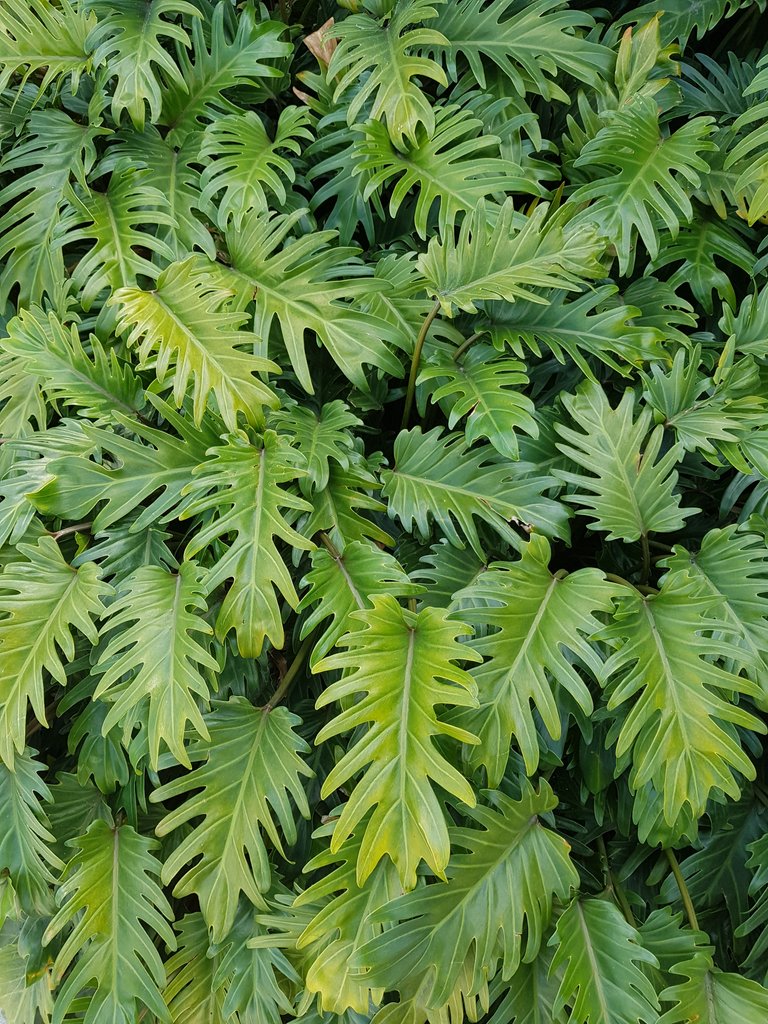 Philodendron "Xanadu"
Philodendron "Xanadu"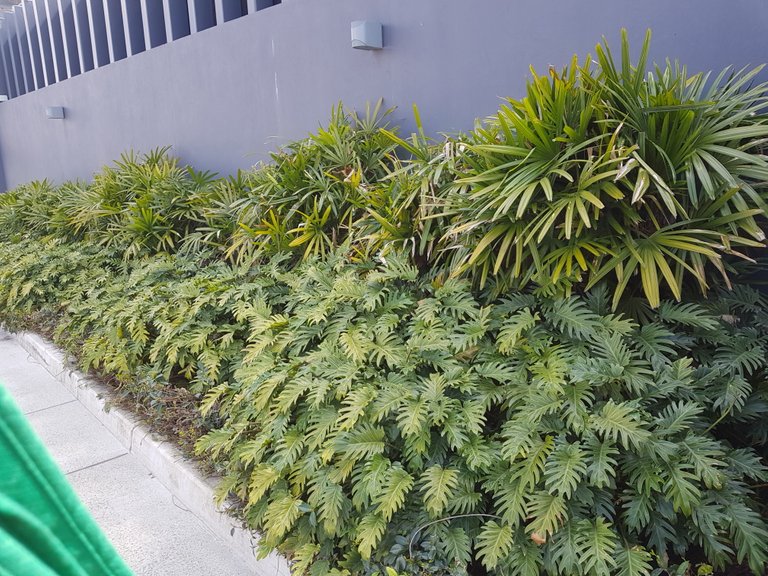 Philodendron "Xanadu" planted outdoors with Rhapis palms behind
Philodendron "Xanadu" planted outdoors with Rhapis palms behind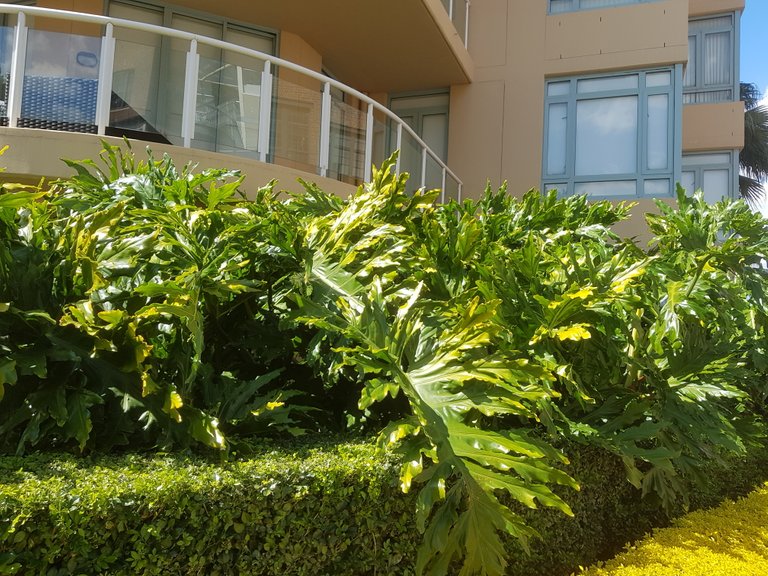 Philodendron selloum planted outside apartments with Buxus hedge in front
Philodendron selloum planted outside apartments with Buxus hedge in front
Philodendron is a classic, and practically no-fail houseplant because it's so easy to grow. Happily, this makes it a pretty common indoor plant to find at your local garden center. The philodendron family is a pretty big one, too -- so you can find a variety of plants that grow in a range of shapes, sizes, and colors.
Many of the traditional philodendron varieties are vines perfect for growing on a totem, up a trellis, or in a hanging basket and some offer pleasing variegated foliage. These are counted as some of the most easy to grow houseplants of all time. Upright-growing philodendrons are just as easy, but typically have larger leaves.
Grow philodendrons just about anywhere. As houseplants they're that easy to keep! The plants grow best in medium or bright-light spots, but tolerate low light exceedingly well.Water philodendrons enough when the soil surface dries. They're tough enough plants they don't mind if you forget to water them now and again. Just take care not to overwater your philodendrons. They will rot if they're kept too wet.
Source: http://www.costafarms.com/plants/philodendron
Fav. comment Award ! Very nice selection of Pics, thanks.
Philodendrons make excellent houseplants as they don't mind low light conditions - their large shiny leaves soak up every bit of sunlight that filters through. This makes them great plants for shady understory spots in subtropical and tropical gardens.
They are easy-to-care-for handsome plants that will also clean the air for you. Give their leaves a wipe over with tepid soft water every now and then to keep them looking good and working efficiently.
source
Silly Sausage Award ! Very nice Pics, thanks.
Philodendron is a type of plant from the Araceae tribe, which has many species. Its name comes from the Greek language, namely from the word philo ("love") and dendron ("tree"). Because of the beauty of the shape and color of the leaves, Philodendron is preferred as an ornamental plant for a room or garden.
Philodendron is a plant that is often found in tropical rainforests like in Australia. It usually grows in damp places, in marshes, on the banks of rivers, or on roadsides. Many members propagate on other plants with the help of their roots.
Here are some other types!
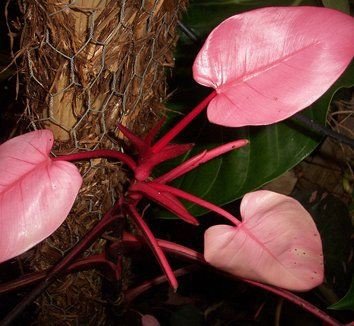 Philodendron Erubescens
Philodendron Erubescens
Philodendron Verrucosum
Philodendron Especies
Philodendron Hybrid
Fav. comment Award ! Lovely Pics .
Philodendron, (genus Philodendron), approximately 450 species of stout-stemmed, climbing herbs of tropical America, which begin life as vines and then transform into epiphytes (plants that live upon other plants).


The foliage of philodendrons is usually green but may be coppery, red, or purplish; parallel leaf veins are usually green or sometimes red or white. Shape, size, and texture of the leaves vary considerably, depending on species and maturity of the plant. The fruit is a white to orange berry. Juvenile and adult phases differ, making it almost impossible to identify different species of small plants. Because many young philodendrons are adapted to the low light levels of rainforests, they are popular potted plants for homes and offices.
Most philodendrons are great climbers, usually growing upward by wrapping their modified roots around the trunks of trees. Once they work their way to the canopy they often transform themselves into epiphytes. Plants with this life strategy are called secondary hemiepiphytes, and they include a similar group of well-known house plants that are sometimes called philodendrons, the monsteras (genus Monstera).
Unlike most plants, the seedlings of hemiepiphytes do not grow toward the Sun; instead they grow toward a tree trunk. Once there, they shift to a light-seeking strategy as they climb to the top using modified roots. Eventually the stem dies at the tree base, severing its connection with the soil.
Sources1234
Fav. comment Award ! Really nice selection of Pics.
Thank you so much for all your support sir!
@ctrl-alt-nwo,
The plant in the last photography is in my country! it's shady but I hate it! Coz my area has a lot of sneaks! Therefore, shady and bushy type meaning they got hiding places around me! For me it's a very bad dream! Anyway these plants looks good for gardening! Specially hotels! Thank you for sharing such great information about them!
Cheers~
This plane have so many uses , you can have it in many places for a lot of needs
Philodendron is a large genus of flowering plants in the Araceae family. As of September 2015, the World Checklist of Selected Plant Families accepted 489 species; other sources accept different numbers. Regardless of number of species, the genus is the second-largest member of the Araceae family.[citation needed] Taxonomically, the genus Philodendron is still poorly known, with many undescribed species. Many are grown as ornamental and indoor plants. The name derives from the Greek words philo- or "love, affection" and dendron or "tree". They are commonly called by their generic name.
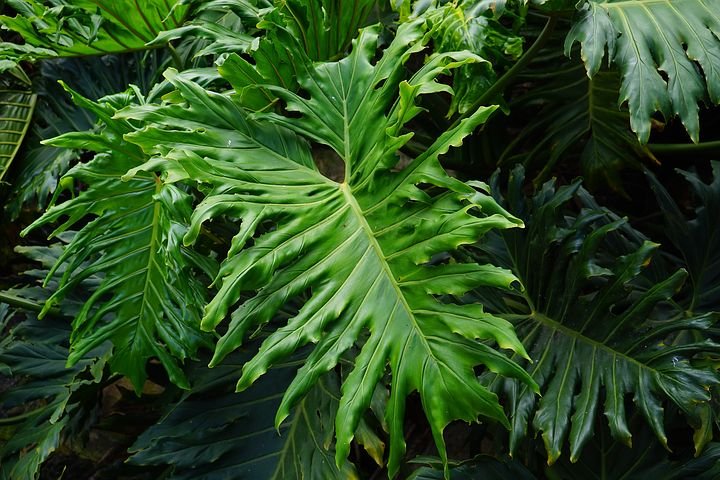
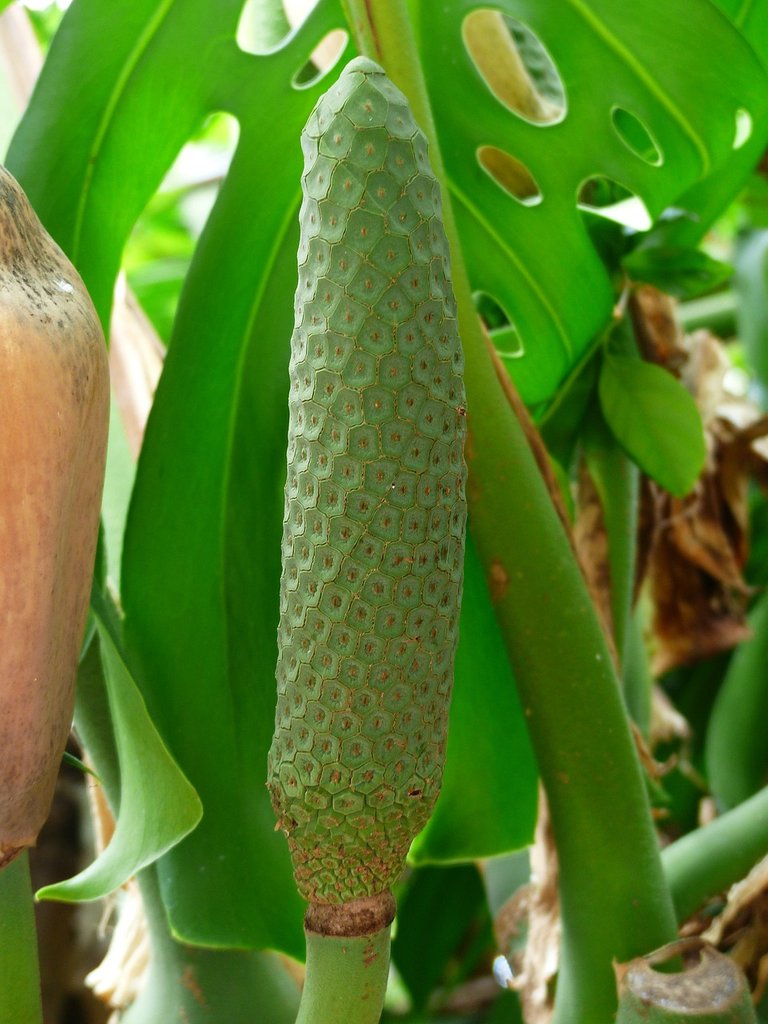

Source
Source
Source
Philodendrons can be grown outdoors in mild climates in shady spots. They thrive in moist soils with high organic matter. In milder climates, they can be grown in pots of soil or in the case of Philodendron oxycardium in containers of water. Indoor plants thrive at temperatures between 15 and 18 °C and can survive at lower light levels than other house plants. Although philodendrons can survive in dark places, they much prefer bright lights. Wiping the leaves off with water will remove any dust and insects. Plants in pots with good root systems will benefit from a weak fertilizer solution every other week.
Source
Great Pics my friend, but i think you will find that the last two photos are actually Monstera diliciosa, which it not a Philodendron. The leaves look similar, but notice the holes in the leaves, and they also produce edible fruit, like a cob of corn, but sweet, one of my favourite fruit. It's easy to confuse the two plants !
Thanks again for your informative response. I don't have much knowledge about plants but recently I have learnt about various plants and flowers from your valuable daily article. Hope I will learn much about more plants.
The philodendron is a type of flowering plant and it is a common species of plant used for indoor decoration. There are a variety of reasons why these indoor plants are used for homes and businesses, but the main reason people like them is they look great and can really add charm and appeal to indoor spaces.
Ambius interior landscaping specialists often use philodendrons when considering species of indoor plants to add to offices. Their bright white flowers make them very attractive and great for decorative purposes. Their overall ability to grow in even harsh conditions also makes them ideal for interior landscapes.
The philodendron is a type of flowering plant and is part of the Araceae family of flowering plants. They are characterized by their spadix, which is the stem encircled by the white portion which is known as the spathe. The spadix is actually a stem covered from top to bottom with tiny flowers (known as an inflorescence). Often times the philodendron is also known as being part of the arum family and sometimes referred to as aroids.
https://www.ambius.com/blog/philodendron-plant-care/
Thanks again for sharing some great photos.
Always a pleasure to share your photographs and blog on twitter to help promote #Steemit and the #Steem #Blockchain.
Have a great weekend.
Stephen
#Promo-Steem #steemtalent #JoinSteemit #Steemit
The Leafy Luxury of Philodendrons. #STEEM #steemtalent #JoinSteemit #Steemit
#gardenersworld #garden #gardening #plant #life #blog #blogger #australia #photography #photographer
Philodendron means "tree-loving," and most species in this genus are tree-climbing vines. Vines seek light by using trees to reach the top of what ecologists call the "canopy," where sunlight is available, unobscured by taller plants. Thus if your Philodendron is given free rein, you can expect it will grow across the room toward your halogen light.
Whether we consider a Philodendron growing indoors or one in the forest, a deeper question follows: How does this plant survive at a very low light level until it reaches the sunlight, or halogen lamp? To answer we need to understand how plants absorb light to make sugars and starchthat is, photosynthesize. Chlorophyll is the familiar pigment that gives plants their green color, but there is no free chlorophyll in the leafit is all bundled with specific proteins. The most abundant of these packages, the light-harvesting protein complex, absorbs light energy and passes it on to other complexes that begin the actual photosynthetic process. When a plant is short of light, it makes more of this light-harvesting complex; when it has plenty of light, it makes less. As a result, leaves at the ground level of a vine growing in the forest are a deeper green than leaves high up on the vine. Leaves are thus adapted to the light intensities they experience.
https://www.scientificamerican.com/article/how-can-philodendron-plan/
Great plant @ctrl-alt-nwo! A Philodendron Selloum or Tree Philodendron is native to South America, but also grows outdoors on the East and Gulf coasts of the United States. Indoors, the easy-care, self-heading Philodendron Selloum takes up a lot of space, often spreading 5ft. or more with 2ft.-3ft. leaves. The dark green, shiny leaves are large and deeply lobed. A Selloum does grow a trunk as it matures, but the huge drooping leaves usually hide it.
A Philodendron Selloum grows well in bright indirect light. In lower light, the leaves turn a darker green; direct sun or too much light burns or fades the leaves.
Unlike other Philodendrons, the Philodendron Selloum likes moist but not soggy soil. During the winter, water less often, keeping the soil barely moist.
Feed a Philodendron Selloum monthly during the spring, summer, and fall with a water-soluble fertilizer diluted to ½ the recommended strength. Too much plant food causes excess salt build up in the soil that can result in leaf burn.
Philodendron Selloums like warm temperatures above 55 degrees. Keep them away from drafts and open doors especially during the winter.
A Philodendron Selloum, a type of tree philodendron, has thinner leaves than many of its relatives and requires a more humid environment to flourish. If your home or office is very dry in the winter, place your Philodendron Selloum near a humidifier or sit it on a wet pebble tray.
A source: https://www.houseplant411.com/houseplant/philodendron-selloum-how-to-grow-plant-care-tree-philodendron
They do have that jungle look.
They have a greener leaves to make them absorb more sunlight, good to be put indoors where there isn't have much light @ctrl-alt-nwo
Well I cant really remember where but I might have seen them somewhere that I am sure of.
Well they do increase the beauty by the way :)
This is a very good idea for covering the ground at the back of my garden! Love the deep green colour and the shape of those leaves.
Posted using Partiko iOS
The name philodendron is derived from the Greek words philo (love) and dendron (tree). This classic plant is among the most popular houseplants, and considered one of the easiest to grow. Lacy tree philodendrons, also commonly known as lacy leaf philodendron, are a large upright vine native to the rainforests of Brazil. It requires space to grow them indoors, since they tend to spread wide. They grow to a height of approximately three feet, but its width can be nearly twice its height.
There are about 400 species of philodendron, a member of the family araceae. Philodendrons fall into two basic categories: vining and non-trailing (also called self-heading). Vines are a perfect choice for a hanging basket or climbing a trellis, while upright types such as lacy tree philodendrons can make a dramatic statement in any space. They are beautiful and exotic plants, and can reach astounding heights in their native environments.
As a tropical plant, philodendron is particularly effective at helping the clean the air we breathe. To take advantage of its air purification qualities for a healthier home environment, place philodendron plants in every 100 square feet of living space and let it do what it does naturally.
https://www.proflowers.com/blog/philodendron-care
Stunning post yet again so nice to see this the-leafy-luxury-of-philodendrons they are very interesting
Very beautiful plant, it reminds me of plants that were in the days of dinosaurs.
@ctrl-alt-nwo, In my opinion you've gave an in depth knowledge of this plant and in my opinion this plant is sounding really unique for sure and that is because, it have the Diversification. But, there is something which is making this plant really different and in my opinion that is, the Structure of some of the leaves which are reflecting as Fingers. And when we feel that we hold lack of creativity or something like that, then we should explore the nature's creations because for sure it will going to give that needed motivation and inspiration.
Wishing you an great day and stay blessed. 🙂
I read that Philodendron is a very unusual one. His wild ancestor is known as Aronik or Arum, who gave the name to the Aronik family. The name of the genus comes from the Greek words phileo - love and dendron - tree: philodendrons use trees as a support. In room culture, philodendrons are valued for the unusual and very diverse shape of the leaves, unpretentiousness and high decorativeness throughout the year.
The structure of the shoot in plants of the genus Philodendron is a mystery. The plants in turn develop two types of leaves: first it is scaly, and behind it is green on a long petiole. A rudimentary inflorescence forms inside a green leaf, and a lateral bud in the axillary scale-like leaf. The main shoot ends with an inflorescence, and from where a part of the stem grows, bearing the following scaly-shaped and green leaves, scientists still do not know. Over the solution of this mystery botanists have unsuccessfully fought for about 150 years.
https://whatflower.ru/houseplants/filodendron/
Warning! So lovely but yet so dangerous :-)
A very interesting article. A wonderful fan spread out at the house.
Greetings
Philodendron selloum - Tree philodendron
Habit and Cultural Information
Category: Tropical
Family: Araceae (Arums)
Origin: Brazil (South America)
Evergreen: Yes
Flower Color: White
Bloomtime: Summer
Synonyms: [Philodendron bipinnatifidum]
Height: 6-10 feet
Width: 6-8 feet
Philodendron selloum (Tree philodendron) - A large shrub to 10' tall and wide with bold shiny, deeply-lobed green leaves up to 4 feet long. The flowers have large white spathes but are inconspicuous under the leaves though older specimens are large enough that the flowers may be seen from below and often aerial roots can also be seen hanging down from the stems or snaking along the soli. This upright species from Brazil has long been grown in California with older plants making dramatic specimen plants. Plant in cool coastal sun to shade inland and irrigate regularly to occasionally - older plants in shade are suprisingly drought resistant. Hardy to short duration temperatures as low as 20° F with some damage to new foliage and reliably hardy to 25° F. There is some confusion regarding the name of this plant and many references that its correct name should be Philodendron bipinnatifidum. The first plant described was Philodendron bipinnatifidum in 1830s by Heinrich Wilhelm Schott from plants collected by him in Brazil and cultivated at Schoenbrunn Palace Gardens, Vienna. Later in the 1850s Karl Koch described Philodendron selloum, a name honoring his source of the plant H. Sello, the head gardener at Sans Souci, the Imperial Prussian estate at Potsdam. Even in the late 19th century there was confusion between these names with some thought may have originated because of the professional rivalry between these two men. If it was a simple naming issue the older name, Philodendron bipinnatifidum, would take precedence, but there are also differences listed in the descriptions of these two species. Most noticeably Philodendron selloum has a spathe that is green colored on the outside while Philodendron bipinnatifidum should be purple-brown. All that we have observed in California have the green spathes. We continue to list it under the name that has long been used for the plant until such time as Philodendron bipinnatifidum is more widely recognized. This description is based on our research and observations made of this plant as it grows in our nursery, in the nursery garden and in other gardens that we have visited. We will also incorporate comments received from others and always appreciate getting feedback of any kind from those who have some additional information about this plant, in particular if this information is contrary to what we have written or if they have additional cultural tips that would aid others in growing Philodendron selloum.
https://www.smgrowers.com/products/plants/plantdisplay.asp?plant_id=2155
Philodendron is a large genus of flowering plants in the Araceae family. As of September 2015, the World Checklist of Selected Plant Families accepted 489 species;[2] other sources accept different numbers.[3][4] Regardless of number of species, the genus is the second-largest member of the Araceae family.[citation needed] Taxonomically, the genus Philodendron is still poorly known, with many undescribed species. Many are grown as ornamental and indoor plants. The name derives from the Greek words philo- or "love, affection" and dendron or "tree". They are commonly called by their generic name.
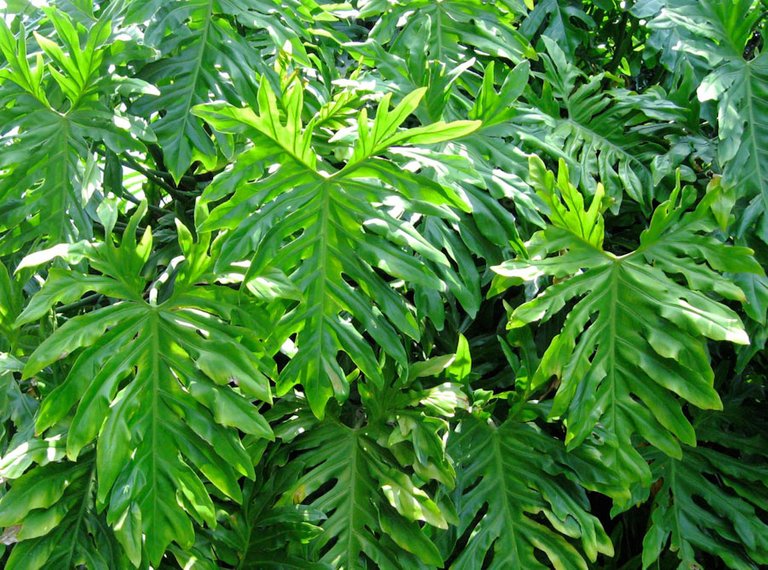
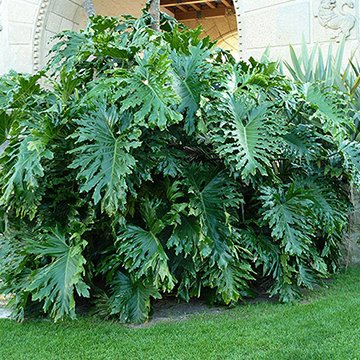

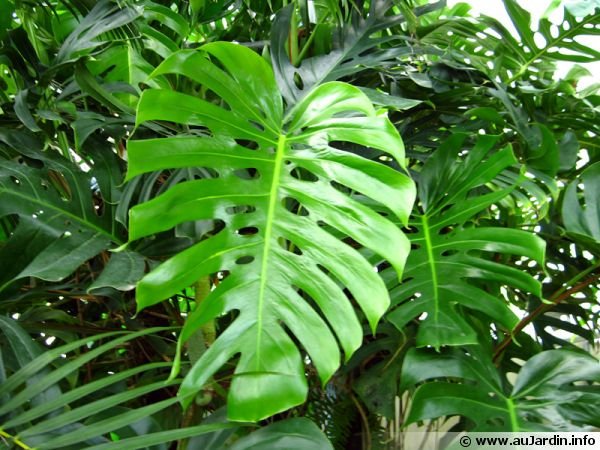

Compared to other genera of the family Araceae, philodendrons have an extremely diverse array of growth methods. The habits of growth can be epiphytic, hemiepiphytic, or rarely terrestrial.[5] Others can show a combination of these growth habits depending on the environment. Hemiepiphytic philodendrons can be classified into two types: primary and secondary hemiepiphytes. A primary hemiepiphytic philodendron starts life high up in the canopy where the seed initially sprouts.
Secondary hemiepiphytes start life on the ground or on part of a tree trunk very close to the ground, where the seeds sprout. These philodendrons have their roots in the ground early in their lives. They then begin climbing up a tree and eventually may become completely epiphytic, doing away with their subterranean roots. Secondary hemiepiphytes do not always start their lives close to a tree. For these philodendrons, the plant will grow with long internodes along the ground until a tree is found. They find a suitable tree by growing towards darker areas, such as the dark shadow of a tree.
Source
Philodendrons (Philodendron spp.) are tropical plants commonly grown indoors, where their shiny, heart-shaped leaves can be admired year round with minimal maintenance and care. A philodendron with leaves that are turning yellow is likely suffering from an cultural problem, although disease may also be to blame.
source
A great variety of Philodendron, unlike what we see here! Beautiful, and thanks for your support.
How to Grow Philodendrons
Because they're so easy to care for, philodendrons rank right at the top for popular plants for homes and offices. Check out these growing tips.
How to Grow Philodendrons
There are two types of philodendrons: climbing and non-climbing. Climbing types, including Philodendron hederaceum var. oxycardium, make popular hanging basket plants. They produce rootlets along the length of their stems that help them climb, but they’re also happy trailing out of a container. Non-climbing types sprout leaves from a growing tip at the base of the plant. They usually have large leaves, and are not always great for the home environment, due to size. If you have the space, though, they are beautiful specimens
source
Congratulations @ctrl-alt-nwo!
Your post was mentioned in the Steemit Hit Parade in the following category:
Great ! Thanks again.
Philodendron Selloum or Tree Philodendron is native to South America, but also grows outdoors on the East and Gulf coasts of the United States. Indoors, the easy-care, self-heading Philodendron Selloum takes up a lot of space, often spreading 5ft. or more with 2ft.-3ft. leaves. The dark green, shiny leaves are large and deeply lobed. A Selloum does grow a trunk as it matures, but the huge drooping leaves usually hide it.
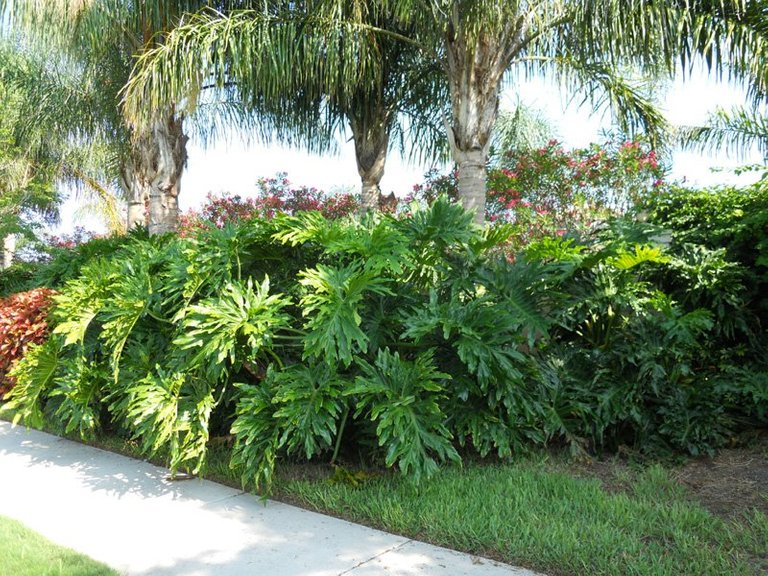
image sources
A Philodendron Selloum grows well in bright indirect light. In lower light, the leaves turn a darker green; direct sun or too much light burns or fades the leaves.
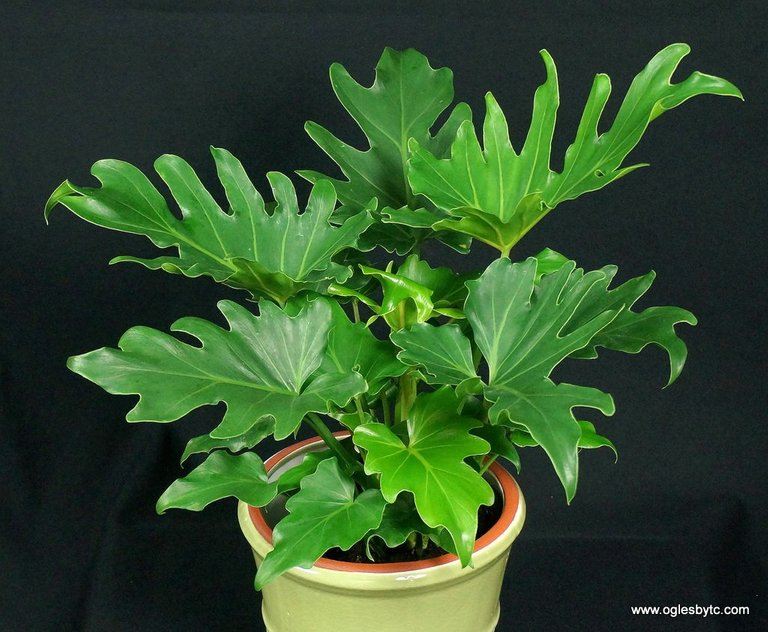
Unlike other Philodendrons, the Philodendron Selloum likes moist but not soggy soil. During the winter, water less often, keeping the soil barely moist.
Feed a Philodendron Selloum monthly during the spring, summer, and fall with a water-soluble fertilizer diluted to ½ the recommended strength. Too much plant food causes excess salt build up in the soil that can result in leaf burn.
image source
Philodendron Selloums like warm temperatures above 55 degrees. Keep them away from drafts and open doors especially during the winter.
A Philodendron Selloum, a type of tree philodendron, has thinner leaves than many of its relatives and requires a more humid environment to flourish. If your home or office is very dry in the winter, place your Philodendron Selloum near a humidifier or sit it on a wet pebble tray.
content source
Philodendrons are among the most popular, tolerant, and durable of all house plants. What they all have in common is there ability to survive neglect and adverse conditions.
source
The Leafy Luxury of Philodendrons.
Philodendron bipinnatifidum is also called split-leaf philodendron. This tropical plant has a semi-upright habit and grows 10 feet tall and wide in warm regions. Grow it as a houseplant and enjoy its glossy leaves and vertical habit.
Philodendron is a genus that offers something for everyone. If you’re looking for an easy-to-care-for houseplant, chances are one of its nearly 500 species will suit. With a name that comes from the Greek, a combination of “love” (philo) and “tree” (dendron), Philodendron is a good-natured and leafy addition to a home
Power user’s tip: Split Leaf Philodendron, sometimes called Lacy Tree Philodendron, is commonly confused with Monstera. An easy way to tell the two apart? Monstera leaves are often punctuated with oblong holes, while the leaves of a Split Leaf Philodendron don’t have holes
sorce: https://www.gardenista.com/posts/gardening-101-philodendron-philodendrons-house-plant-care/
The name philodendron is derived from the Greek words philo (love) and dendron (tree). This classic plant is among the most popular houseplants, and considered one of the easiest to grow. Lacy tree philodendrons, also commonly known as lacy leaf philodendron, are a large upright vine native to the rainforests of Brazil. It requires space to grow them indoors, since they tend to spread wide. They grow to a height of approximately three feet, but its width can be nearly twice its height.
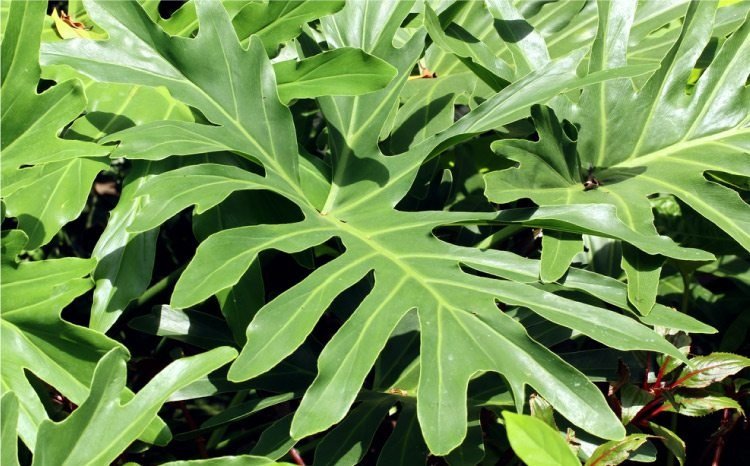
There are about 400 species of philodendron, a member of the family araceae. Philodendrons fall into two basic categories: vining and non-trailing (also called self-heading). Vines are a perfect choice for a hanging basket or climbing a trellis, while upright types such as lacy tree philodendrons can make a dramatic statement in any space. They are beautiful and exotic plants, and can reach astounding heights in their native environments.
As a tropical plant, philodendron is particularly effective at helping the clean the air we breathe. To take advantage of its air purification qualities for a healthier home environment, place philodendron plants in every 100 square feet of living space and let it do what it does naturally.
Philodendron are sometimes confused with pothos plants, but you can tell the difference by the leaves. They are similar in shape, but pothos leaves usually are variegated with yellow or white splotches.
Content Source
This is fully green plant . It means it is very good for climate . Big and unique green leaves are looking beautiful. Good plant for home and road side .
Philodendron - comes from tropical rain forests. The plant is very decorative and often grown in artificial conditions, decorating with its presence modern interiors and greenhouses.
Philodendron is an evergreen perennial of the Aroid family. Most of the genus members are arboreal forms or climbing plants that are half-epiphytic or epiphyte. The choice of the generic name is explained by the lian-like lifestyle of many Philodendrons, using trees as a support and source of supplementary food. Translated from the Greek word "philodendron" means "I love the tree."
Philodendrons can be seen in Australia and Asia, on Fr. Pacific Ocean. However, it is believed that these places are not the biological homeland of plants, they got there (were introduced) by accident. Settling in a certain area, Philodendrons grow rapidly, displacing other plants.
https://whatflower.ru/houseplants/filodendron/
Philodenderon Light Requirements
Philodendrons do just fine in low light conditions, one of the best aspects of their versatility. Plants that receive medium or indirect light, however, will grow faster and produce more leaves. Philodendrons should not be placed in direct sunlight.
Watering Your Philodendron
Philodendrons may be grown in soil or just in water. Plants that live in soil should be watered when half of the soil is dry. As with most plants, yellow leaves indicate over-watering and brown leaves indicate under-watering. You can tell when a philodendron needs water because its leaves will appear wilted. When watered, the plant will reward you with a perky appearance.
Philodendrons also thrive in containers with just water. Monitor the water closely because your philodendron may drink it faster than you anticipate. One thing to note is that once a plant is used to living in either soil or water, it doesn't always do well being transferred to the other medium.
source
The plant in the last photography is in my nation! it's obscure yet I loathe it! Coz my zone has a great deal of sneaks! Thusly, obscure and shaggy sort meaning they got concealing spots around me! For me it's an awful dream! At any rate these plants searches useful for cultivating! Uniquely lodgings! Much obliged to you for sharing such incredible data about them. @ctrl-alt-nwo
This is a good green plant . Big green leaves are amazing . Green color plants are good for climate . Thanks for sharing this blog
Philodendron bipinnatifidum
Philodendron bipinnatifidum (common names: lacy tree philodendron, selloum, horsehead philodendron[1]) is a plant that belongs to the family Araceae and subgenus Meconostigma, one of three subgenera within the genus Philodendron. The commonly used name Philodendron selloum is a synonym (Mayo 1991). This plant is native to South America, namely to Brazil, Bolivia, Argentina, and Paraguay, but is also cultivated as a landscape plant in tropical, subtropical and warm temperate climates.
Growth habitat
Philodendron bipinnatifidum is a tropical plant that is usually grown in full sun, but can tolerate and adapt to deep shade. It grows best in rich, moisture-retentive soil that can be slightly alkaline. However, it cannot tolerate high salt concentration in soil. It is capable of supporting itself at massive heights by producing tree-like bases. However, it will exhibit epiphytic characteristics if given the opportunity to attach itself to a nearby supporting tree and climb upon it. The trunk of this plant can send down many strong aerial roots that not only give support to the overall plant mass, but also serve to absorb water and nutrients from the soil. This plant is greatly known for its ease in covering a land mass, and typically spread out its tree-like trunk from anywhere between eight and ten feet. Alternatively, if grown in cooler climates with at least some freezing winter weather, its entire aboveground structures will die back completely at a hard frost and then sprout back from the roots the following spring.
Distinguishing features
The leaves are simple, large, deeply lobed, and are usually drooping. These can grow up to 1.5 meters long, and are attached to long, smooth petioles. They are a deep green color, and since these plants are grown in the tropics, there is no apparent color change that correlates with the fall season. The trunk of P. bipinnatifidum is relatively thick and woody with characteristic “eye-drop” leaf scars. Approximately 15–20 years is required for P. bipinnatifidum to grow to an appropriate size and produce flowers in an indoor environment where space is limited. The small, petalless flowers are on a spadix that is enclosed within a spathe. They are usually white or inflorescent.
https://en.wikipedia.org/wiki/Philodendron_bipinnatifidum
Philodendron xanadu is a plant that belongs to the family Araceae and subgenus Meconostigma, one of three subgenera within the genus Philodendron. This plant is native to Brazil, but is widely cultivated as a landscape plant in tropical, subtropical and warm temperate climates.

Philodendron xanaduScientific classificationKingdom:PlantaeClade:AngiospermsClade:MonocotsOrder:AlismatalesFamily:AraceaeGenus:PhilodendronSpecies:P. xanadu
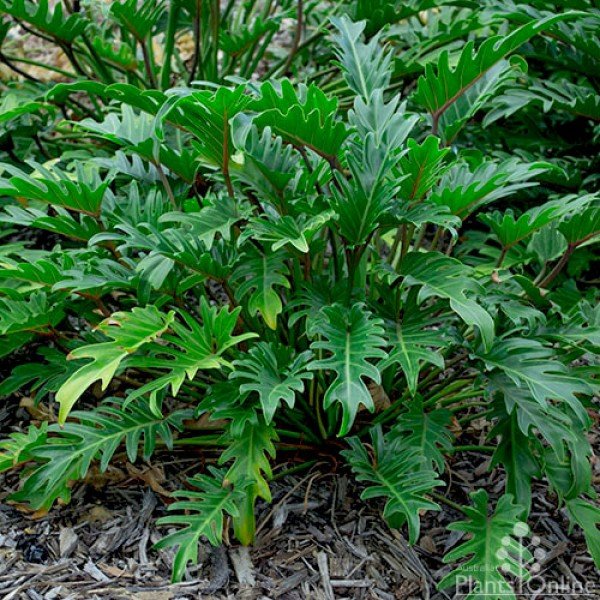
This plant was originally reported to be a selected chance seedling that arose in 1983 in a Western Australian nursery. It was thought to be a sport or hybrid of P. bipinnatifidum and named Philodendron 'Winterbourn' and protected under Plant Breeder Rights in Australia. It was also sold under the name P. 'Showboat'. It was renamed 'Xanadu' by House Plants of Australia and released as their plant of the year in 1988. That name was trademarked in the United States using the cultivar name 'Winterbourn' on January 19, 1988. That patent has since expired and there are now substantiated claims that this plant is not a hybrid or nursery grown cultivar but actually originated from seed collected from a wild plant in Brazil.
Growth habi
Philodendron xanadu eventually forms dense clumps up to 1.5 metres tall by 2 metres wide. It has deeply dissected, lobed leaves up to 40 cm long by 30 cm wide glossy green leaves. Its flowers have dark red spathes. It may occasionally produce aerial roots.[3]
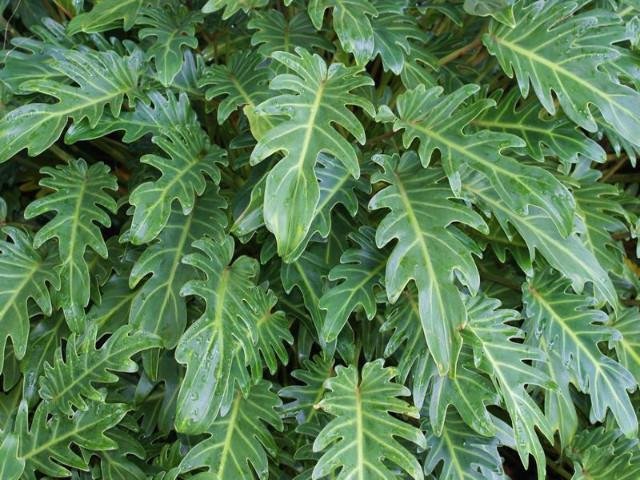
Distinguishing features
Philodendron xanadu is a species within the self-heading Meconostigma group of Philodendrons. "It differs from all other species of Meconostigma in details of the sexual parts of its spadix, the shape of the leaf scars on the rhizomes, shape of leaf blade, intravaginal squamules, etc".[4]
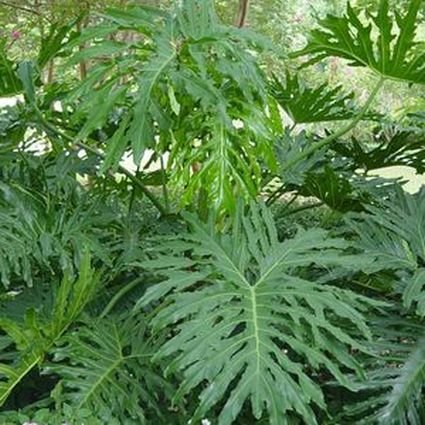
Cultivation
Philodendron xanadu is cultivated as a landscape plant in tropical, subtropical and warm temperate countries including warmer parts of the United States, such as Florida, Hawaii and California, South Africa, Australia and northern New Zealand. It is grown as a houseplant in cooler regions.
[Source]<en.m.wikipedia.org/wiki/Philodendron_xanadu>
Botanical Name: Philodendron scandens
Heartleaf philodendron is a popular house plant because it is extremely easy to grow. It's also known as the Sweetheart Plant.
Heart-shaped, glossy leaves emerge bronze, then quickly turn green. The leaves are typically 2-4 in (5-10 cm) long, and cover its long, slender stems that can grow to 4 ft (1.2 m) or more.
source
HEARTLEAF PHILODENDRON
SCANDENS OXYCARDIUM
PHILODENDRON CORDATUM SWEETHEART PHILODENDRON
There are over 200 different varieties of philodendron plants that come in different sizes, colors, and leaf shapes. The Heartleaf or Sweetheart Philodendron has dark green, shiny, heart-shaped leaves and looks great as a table or hanging plant. Heartleaf Philodendrons are some of the most popular indoor plants we use in homes and offices because they thrive on neglect and are almost impossible to kill. Another great plus, philodendron plants remove air-born toxins such as formaldehyde from the air.
All philodendron are considered poisonous and should be kept away from pets and children. Read more about common houseplants that are poisonous in Don’t Feed Me To Your Cat! A Guide to Poisonous Houseplants.
LIGHTA Heartleaf Philodendron can survive in low light conditions, but grows faster and produces more leaves in medium or bright indirect light. Never put any philodendron plant in direct sun.WATERWater well and then allow the top 50% of the soil to dry out before watering again. Yellow leaves on a Heartleaf Philodendron indicate over-watering and brown leaves mean the plant needs more water.FERTILIZERFeed a Heartleaf Philodendron monthly in the spring and summer with a basic houseplant food diluted to 1/2 the recommended strength. Fertilize every other month in the fall and winter. Heartleaf philodendron are fast growing houseplants and need quite a bit of plant food, but should be fertilized only when they are actively producing new leaves.TEMPERATUREHeartleaf Philodendrons grow well in temperatures between 70°-80ºF (24°-27ºC) during the day and above 55º F (13ºC) at night.HUMIDITYBasic household humidity is fine for a Heartleaf Philodendron though higher humidity encourages larger leaves.FLOWERINGA Heartleaf Philodendron does not produce flowers indoors.PESTSKeep an eye out for Aphids, spider mites, Mealy Bugs, thrip, and scale.DISEASESRoot-rot from over-watering is the main disease that affects a Heartleaf Philodendron.SOILUse a well-aerated all purpose potting soil that drains quickly.
https://www.houseplant411.com/houseplant/heart-leaf-philodendron-how-to-grow-care-sweetheart-philodendron
Long and good shape green leaves are giving different look to this plant . This is good plant for home and climate . Thanks
magoo-2 found a series of multi accounts of a same owner is following your articles to cheat your generous rewards.
magoo-2 found these accounts are suspicious & can be multi accounts of a single owner. Conclusion is based on last 1 year transactions:
@sthitaprajna
@crypto-wisdom
@shivohum2015
@spiritualpower
magoo-2
Check our latest multi comment spam update report
You are totally fool robo. Whats wrong with you .
Philodendron belongs to the Arums or Aroid (Araceae), a family which is characterized by its distinctive spathe-and-spadix blooms. They are native to the West Indies and the tropical rain forests of Central and South America. The botanical name comes from the Greek: philos(loving) and dendron (tree), suggesting that most of its species are vines, although some are self-heading and do not require support.
source
magoo-2 found a series of multi accounts of a same owner is following your articles to cheat your generous rewards.
magoo-2 found these accounts are suspicious & can be multi accounts of a single owner. Conclusion is based on last 30 days transactions:
@astique
@alinaloredana
@archista
magoo-2
Check our latest multi comment spam update report
Philodendrons may be grown in soil or just in water. Plants that live in soil should be watered when half of the soil is dry. As with most plants, yellow leaves indicate over-watering and brown leaves indicate under-watering. You can tell when a philodendron needs water because its leaves will appear wilted. When watered, the plant will reward you with a perky appearance.
source
magoo-2 found a series of multi accounts of a same owner is following your articles to cheat your generous rewards.
magoo-2 found these accounts are suspicious & can be multi accounts of a single owner. Conclusion is based on last 1 year transactions:
@kheightces
@thytheso
@mabir
@ristotle
@tanuesh
@alizamanjutt454
@eastmund
@reicher
@vijayar
@lycusa
@snorio
@alexeyy
@surenda
@isuru1127
magoo-2
Check our latest multi comment spam update report
a very beautiful plant. Thank you for informing me, sir